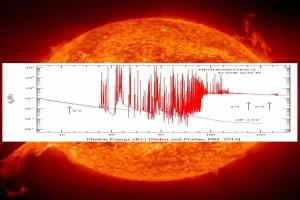Everything in the universe follows a life cycle—humans, plants, planets and even the sun, which has an estimated lifespan of another six to seven billion years before using all its hydrogen fuel. Sultana Nahar, a senior research professor in the Department of Astronomy at The Ohio State University, has dedicated decades to the study of the sun’s composition and evolution, with significant support from the Ohio Supercomputer Center (OSC).
“I started working with OSC because these initiatives are largely computational and need high performance, powerful computers,” Nahar said.
Among her primary research endeavors are the Opacity and Iron Projects, which require accurate atomic data.
Nahar, Professor Anil Pradham and their colleagues study a fundamental quality of the sun called the opacity of the plasma. It determines how much radiation is absorbed by the plasma particles and also determines the sun’s elemental abundances, which are crucial to the study of astronomical objects. Elemental abundances tell researchers what elements exist in a star and what their abundances are relative to hydrogen, which is the most abundant element in the universe. This information helps Nahar and her team learn about the sun's chemical evolution and its physical conditions.

The sun has three regions: the core, the radiative zone and the convective zone. The core, where nuclear fusion occurs, powers the sun’s heat and light. Surrounding the core, the radiative zone transmits energy outward as radiation. The convective zone, the outermost layer of the sun’s interior, is where expanding hot plasma transports energy toward the sun’s surface. As the plasma moves away from the core, it cools, eventually reaching around 5,700 degrees Celsius (10,290 F) at the top of the zone.
Iron’s abundance is crucial in determining a star’s opacity of the plasma, due to its high capacity for radiation absorption.
“Inside the sun, there is a large amount of iron,” Nahar explains. Most stars and astronomical objects display iron lines, which are created in stars and supernova explosions.
Initially, the Opacity Project included iron in its studies, but lacked important information about it. Its complexity warranted dedicated research, leading to the formation of the Iron Project. There are three iron ions: Fe XVII, Fe XVIII and Fe XIX, which have been the focus of this project.
Nahar and her team have studied two main atomic processes known as photoexcitation and photoionization, each determining opacity. Iron goes through both processes via absorbing radiation by its electrons.
Initially, the data did not match the expected observations until OSC’s resources were utilized.
“We knew something was wrong somewhere in the model but needed more computational power,” Nahar explained.
The findings since utilizing OSC for the Iron Project have been substantial. With OSC’s support, Nahar and her team have conducted the most comprehensive study of photoionization processes, which are most common in stars, focusing on the most relevant iron ions in the sun. They have also identified several key characteristics of photoionization that were previously unknown, later verified by experiments at ALS-Livermore and BESSY-Germany.

“We have obtained a vast amount of high accuracy and complete sets of atomic data compared to currently available data for these processes by carrying out the largest R-matrix calculations not possible before using the high performance computers of OSC,” Nahar said. “These computations revealed new physics of characteristic features not realized before.”
In addition, researchers have established foundational physics for opacity calculations, detailed in a series of four papers published in the Journal of Physics in 2024, which the astronomy community has highly praised. All atomic data are available in Nahar’s database, NORAD-Atomic-Data at Ohio State, and many findings are illustrated in Pradhan and Nahar’s book “Atomic Astrophysics and Spectroscopy” (Cambridge University Press, 2011).
“OSC has had to make special arrangements for us because we are using so many computational resources,” Nahar said. “OSC has helped us not only with resources but also with any technical problems we’ve encountered.”
As technology and OSC’s resources advance, Nahar and her team delve deeper into studying the sun. Their discoveries have significant applications not only in space but also here on Earth.
“The research will be invaluable in engineering, nuclear fusion energy devices, and medical facilities for radiation therapy,” Nahar said.
Written by Lexi Biasi
Nahar presented her research at OSC’s April 2024 Research Symposium, which is held annually each spring to create engagement within the high performance computing community.
The Ohio Supercomputer Center (OSC) addresses the rising computational demands of academic and industrial research communities by providing a robust shared infrastructure and proven expertise in advanced modeling, simulation and analysis. OSC empowers scientists with the services essential to making extraordinary discoveries and innovations, partners with businesses and industry to leverage computational science as a competitive force in the global knowledge economy and leads efforts to equip the workforce with the key technology skills required for 21st century jobs.